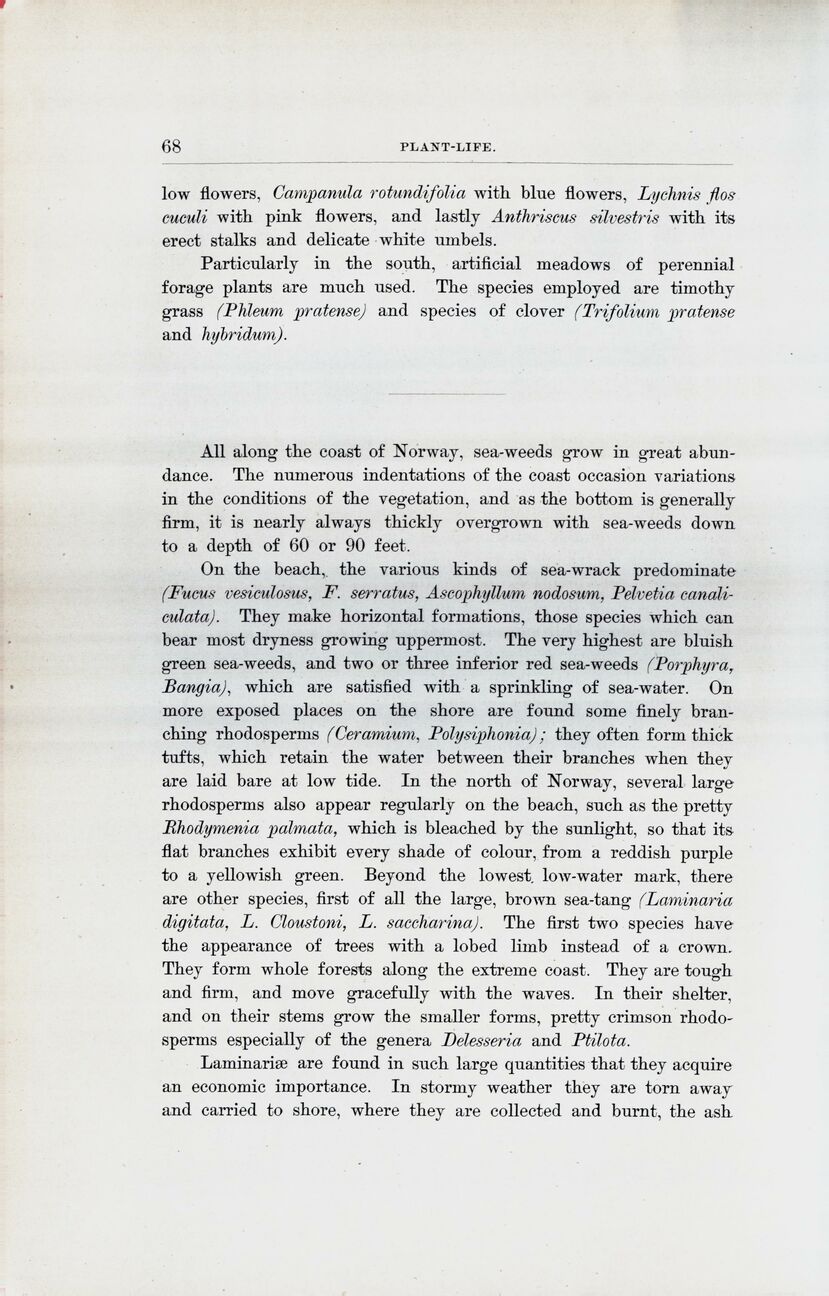
Full resolution (JPEG)
- On this page / på denna sida
- Plant Life, by H. H. Gran

<< prev. page << föreg. sida << >> nästa sida >> next page >>
Below is the raw OCR text
from the above scanned image.
Do you see an error? Proofread the page now!
Här nedan syns maskintolkade texten från faksimilbilden ovan.
Ser du något fel? Korrekturläs sidan nu!
This page has been proofread at least once.
(diff)
(history)
Denna sida har korrekturlästs minst en gång.
(skillnad)
(historik)
yellow flowers, Campanula rotundifolia with blue flowers, Lychnis flos
cuculi with pink flowers, and lastly Anthriscus silvestris with its
erect stalks and delicate white umbels.
Particularly in the south, artificial meadows of perennial
forage plants are much used. The species employed are timothy
grass (Phleum pratense) and species of clover (Trifolium pratense
and hybridum).
*
All along the coast of Norway, sea-weeds grow in great
abundance. The numerous indentations of the coast occasion variations
in the conditions of the vegetation, and as the bottom is generally
firm, it is nearly always thickly overgrown with sea-weeds down
to a depth of 60 or 90 feet.
On the beach, the various kinds of sea-wrack predominate
(Fucus vesiculosus, F. serratus, Ascophyllum nodosum, Pelvetia
canaliculata). They make horizontal formations, those species which can
bear most dryness growing uppermost. The very highest are bluish
green sea-weeds, and two or three inferior red sea-weeds (Porphyra,
Bangia), which are satisfied with a sprinkling of sea-water. On
more exposed places on the shore are found some finely
branching rhodosperms (Ceramium, Polysiphonia); they often form thick
tufts, which retain the water between their branches when they
are laid bare at low tide. In the north of Norway, several large
rhodosperms also appear regularly on the beach, such as the pretty
Rhodymenia palmata, which is bleached by the sunlight, so that its
flat branches exhibit every shade of colour, from a reddish purple
to a yellowish green. Beyond the lowest low-water mark, there
are other species, first of all the large, brown sea-tang (Laminaria
digitata, L. Cloustoni, L. saccharina). The first two species have
the appearance of trees with a lobed limb instead of a crown.
They form whole forests along the extreme coast. They are tough
and firm, and move gracefully with the waves. In their shelter,
and on their stems grow the smaller forms, pretty crimson
rhodosperms especially of the genera Delesseria and Ptilota.
Laminariæ are found in such large quantities that they acquire
an economic importance. In stormy weather they are torn away
and carried to shore, where they are collected and burnt, the ash
<< prev. page << föreg. sida << >> nästa sida >> next page >>
Project Runeberg, Sun Dec 10 21:09:24 2023
(aronsson)
(diff)
(history)
(download)
<< Previous
Next >>
https://runeberg.org/norparis/0080.html



